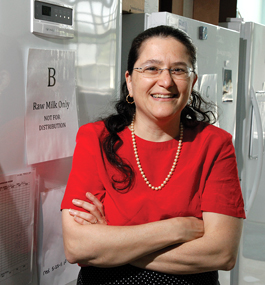The Milk of Human Kindness

Mike Lovett
Naomi Bar-Yam ’79, PH.D.’97, P’12
by Aliza Libman
A century after the first milk bank in North America was established in Massachusetts, and three decades after the AIDS crisis helped shutter many banks across the country because of safety concerns, the practice of donating breast milk is resurging. That “breast is best” for newborns’ health — especially vulnerable preemies — is now scientific fact. But not all mothers are able to nurse their own children, especially those of premature infants.
Then there are those moms who can nurse their own and then some. Naomi Bar-Yam ’79, Ph.D.’97, was living in Israel in 1990 when her son, Maayan ’12, was born prematurely, landing him in the hospital’s neonatal intensive care unit (NICU). Bar-Yam says that as the only mother in the NICU with breast milk to spare, she donated some of her “liquid gold” — so called because of its golden hue and irreproducible nutrients, antibodies and growth factors — for another NICU baby.
Fast-forward a dozen years, and Bar-Yam, a childbirth educator and doula (a woman who supports new mothers and families through labor and childbirth), began to research how to revive milk banking in New England. By 2006, Bar-Yam was in the embryonic stages of creating the Mothers’ Milk Bank of New England (MMBNE). Working with other like-minded people from all over New England, Bar-Yam built an advisory board, secured space in Newtonville, Mass., and gained accreditation from the Human Milk Banking Association of North America, which issues guidelines for pasteurization and safe banking, similar to those for blood banking.
Today, MMBNE, the 11th milk bank in North America, is a far cry from Bar-Yam’s informal exposure to the practice of donating breast milk when her son was in the NICU. “Milk banks are really designed to help premature, hospitalized babies,” she says. “Our screening procedures for both mothers and the milk they donate are so involved because we’re taking surplus milk from a healthy, full-term baby and providing it to a baby who weighs just 1 or 2 pounds.”
Since 2008, MMBNE has distributed donor milk from an affiliated milk bank in Ohio, while building and equipping its own lab. Donors who send their milk to MMBNE must undergo blood tests and health screening. The milk is later pasteurized to further protect the recipient baby.
“We get calls all the time from people who want to donate and who want to receive milk,” Bar-Yam says, estimating that milk distributed by MMBNE has reached 50 to 75 families, mostly through hospitals. Bar-Yam’s work has also focused on the educational aspect of milk banking, prompting premier hospitals such as Brigham and Women’s in Boston to provide banked human milk as the standard of care to all premature babies. Six new milk banks in development in North America are evidence of the reemergence of breastfeeding, which is just how Bar-Yam likes it.
“Our goal is really to be a part of a larger picture of broad-based lactation support, not just in the medical community but throughout society,” she says.
Aliza Libman is a freelance writer living in Brookline, Mass.
